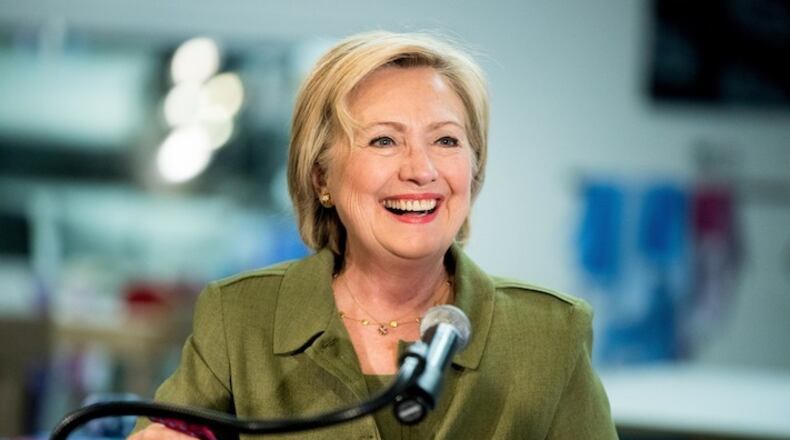After 45 years in Washington, Hillary Clinton is asking for a promotion. Once again, she is competing for the title of commander in chief, but this year she's made it to the final interview.
Should she win, she would be the first female president of the United States, a point her campaign has worked tirelessly to drive home. After last Tuesday's formal nomination, Clinton addressed the crowd at the Democratic National Convention in a video message saying, "I can't believe we just put the biggest crack in that glass ceiling yet."
This crack in the glass ceiling leaves her in uncharted territory. If Clinton were to win the presidency she would enter the Oval Office in a nation sharply divided by race, religion and political affiliation. Some political observers have suggested this could make her a scapegoat teetering over the edge of a glass cliff, like some of her fellow female leaders, but others see it as laying the groundwork for her to be a trailblazing pioneer.
The term glass cliff was coined in 2004 by British professors Michelle K. Ryan and Alexander Haslam from the University of Exeter. The theory is simple — women are more likely to be put into leadership roles in turbulent times. Examples include Marissa Mayer taking over as CEO for Yahoo during a time of falling web traffic and ad revenue, or Theresa May becoming the prime minister after Britain voted to leave the European Union and potential male candidates for the position walked away.
Given that there are so few women in top positions of power, Haslam said this small sample size makes it difficult to study the glass cliff phenomena. Some examples, such as May, are more explicit than others. The Brexit aftermath showed the world how men sometimes back away in times of crisis, he said, in this case leaving only May and Andrea Leadsom to step up to the task of prime minister of the United Kingdom.
These glass cliff opportunities are often pushed onto women as a chance to prove themselves, Haslam said. This doesn't happen for men because men are offered more opportunities to excel and can therefore be picky when choosing which to take on.
In the case of Clinton, Haslam said that the glass cliff theory applied more explicitly to her 2008 campaign than to this year's presidential election and Clinton's historic role in it.
Having a woman and an African-American as the major Democratic candidates during a campaign taking place in the midst of the Wall Street financial crisis made them easier potential scapegoats. Barack Obama and Clinton both faced challenges in carrying the burden of being a role model for people of color and women respectively while taking on daunting challenges.
The 2016 election, however, is different in that there are not imminent threats or a new crisis unfolding. This does not eliminate the gendered politics that surround Clinton's campaign, potential presidency or entire political career leading up to her nomination, Haslam said.
"The glass cliff is relevant to the big Hillary narrative, but maybe not right now," Haslam said.
Rather than representing a glass cliff, this change in the political landscape can be used as a launching pad for women in power, Dana Brown, political science professor at Chatham University and executive director of the Pennsylvania Center for Women and Politics said.
"They're that physical embodiment of change," Brown said. "(Voters are) looking for something that's different from the 'norm,' and for so long politics looked like white men, typically heterosexual, so people are looking for something new."
Women and men are socialized differently and bring those diverse experiences into their policies, Brown said.
Being excluded from the narrative for so long has led women leaders to adapt, said Anne Wakabayashi, Pennsylvania executive director of Emerge America, a training program for Democratic women running for office.
"Women a lot of time have to flip the script," Wakabayashi said. "There are barriers that exist in women running for office and the way people view women candidates that force them to have to come up with unique, different ways to think outside of the box."
In part, the different, and arguably more difficult, obstacles women face in the workplace are what make them natural relationship builders, said Nancy L. Cohen, author of "Breakthrough: The Making of America's First Woman President."
Research shows they tend to be more open to comprise and choose more pragmatic approaches to problem-solving compared to men, Cohen said.
"I don't think this is some gender trait," Cohen said. "... I think it's because women were outsiders, until recently. When women came in they had to work around those boys clubs, and the main way they worked around this was to reach across the aisle."
Research by the Center for Women and Politics among state legislators show that women are more likely to be bipartisan and reach agreements with other political parties, Brown said. The tension between political parties and within the Democratic Party has produced Clinton's latest campaign slogan "Stronger Together," the overarching theme of the Democratic National Convention.
Even the language women use is unifying, Brown said. Women are more likely to use "we" statements rather than "I" statements in comparison to men.
During his acceptance speech in Cleveland, Republican nominee Donald Trump talked to his delegates about the political system saying, "No one knows the system better than me, which is why I alone can fix this."
In response, Clinton told Democrats in Philadelphia, "Americans don't say: 'I alone can fix it.' We say 'we'll fix it together.' "
About the Author
Keep Reading
The Latest
Featured



